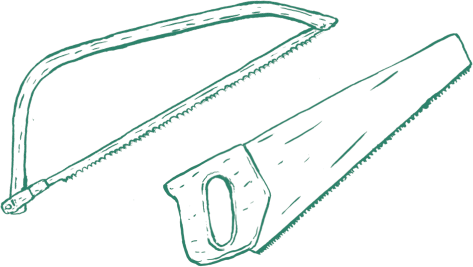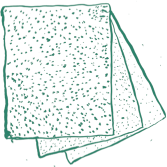Helpful Extras
One of the joys of whittling is its rudimental simplicity. As the world becomes familiar with increasingly complicated and elaborate apparatus, be it for work, entertainment or practicality, there’s something remarkably satisfying in working with a penknife and wood. For the most part, the 50 carving projects in this book involve only these two basic components, but occasionally a project will call for one or more items from the following list. Although not all vital necessities, access to a good saw, as well as a few sandpaper options, will prove immensely useful in the undertaking of any carving project. More information on suppliers of the tools listed can be found in Sources.

Safety
There are many precautions that can be taken to reduce the risks of carving with a sharp knife. Performing even the most basic of whittling strokes can present the potential for a hazardous incident. Therefore you may wish to purchase a pair of cut-resistant gloves or a simple thumb guard. Whittling gloves are typically lined with steel thread and fibreglass, offering protection for your hands without majorly affecting their dexterity. A thumb guard will be less comprehensively protective, but it will prove enormously useful when making delicate paring cuts.

Saws
Whether you’re taking a branch from a tree or cutting larger pieces of wood to size, a bow saw (above left) will make light work of the task in hand. With its deeply toothed, free-strung blade, this type of saw is designed for cutting green wood quickly and easily. When sawing smaller diameter wood, or making neater, more precise cuts, a wood saw (above centre) is a preferable tool to use. Although there is a variety of wood saws available, a fine-toothed blade is particularly useful for this sort of task, cutting cleanly and with increased accuracy.

Sandpaper
While the merits of sanding are obvious, it is also worth noting that not all wood carvings need conclude with the application of sandpaper. Sanding will certainly smooth the pares and cuts made while sculpting, but it will also disguise them, removing character from what is ultimately a homemade and personal craft. That said, sandpaper is generally an indispensable component of the whittler’s kit, however often it’s employed.
Sandpaper is graded according to ‘grit’ size. This relates to the size of the abrasive fragments glued to the paper itself: larger grit for sanding rougher surfaces, smaller grit for sanding a finer finish. Although there is a vast range of grit sizes, the ones referred to in this book are: ‘coarse’ (40–50 grit), ‘medium’ (60–80 grit) and ‘fine’ (100–120 grit).
In the absence of sandpaper, particularly if you’re out and about, stones displaying a coarse surface can make for a helpful, foraged alternative.

Drill and bits
Drill bits are helpful implements to have handy, whether used in partnership with a drill or as tools in their own right. While their sharp point can be used to indent or mark a sculpture, they’re also, let’s face it, much quicker at making precise holes than a knife, particularly when carving out a substantial section of wood. A selection of bit sizes is ideal, including some of the larger, flat-headed variety.

Clamp and oil
Occasionally the use of a small G- or C-clamp can make certain carving actions a little easier to tackle. None of the projects in this book depends on the use of a clamp, but they can be useful.
As outlined in Maintaining your blade, a periodic application of oil helps to prolong the life of a penknife and keep it in good working order. Any high-quality, multipurpose oil will do the trick, applied lightly to the hinge and blade. Applying finishing oil, such as boiled linseed, Danish or teak oil, can be a nice way to round off whittling projects made using dry, seasoned wood. Not only does the oil enrich the carving’s appearance, but it also helps to preserve the wood itself. Finishing oil should be applied sparingly at first, allowing time for it to dry before adding a second or third coat.




